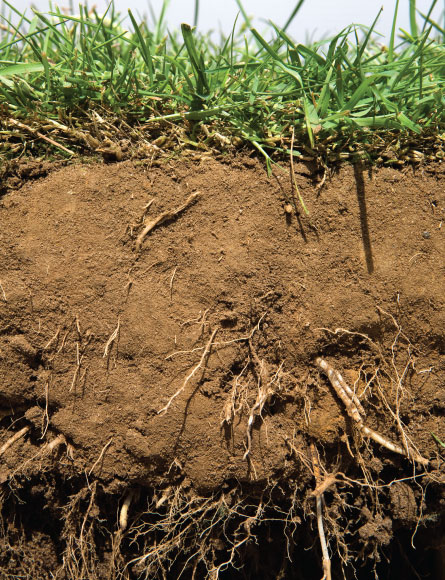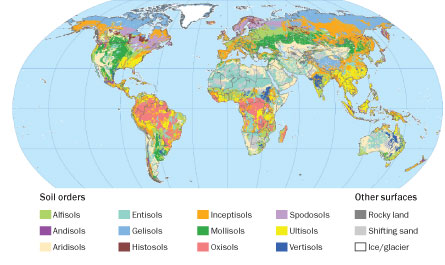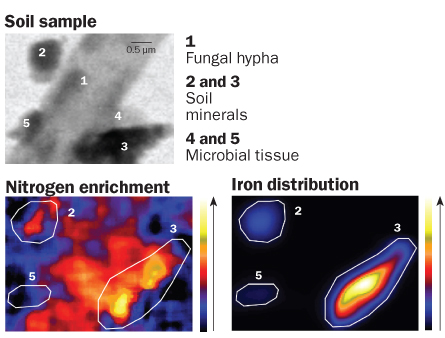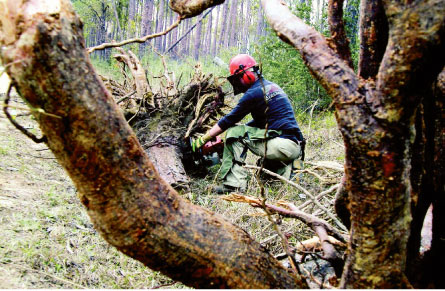- More than 2 years ago
Scientists around the world are closing in on some dirty truths about carbon emissions and climate change.



A cover-up is plainly involved; it’s not about scandal but dirt itself. That means soil, the upper layer of earth typically a few feet but sometimes 10 feet or more thick, usually black or dark brown. Below is rock or other material that contains little of the organic matter, derived mainly from plants, that gives good farmland its fertility.
The last few decades have seen a string of discoveries that not only upset long-cherished theories about soil, but also could lead to ways of improving agriculture by altering factors that control soil quality, say to favor certain soil microbes over others.
Perhaps more important in the long run, the findings will bring a far deeper understanding of soil’s response to climate change. This new understanding may include whether soil will speed up the pace of warming or slow it down as atmospheric concentrations of carbon dioxide and other carbon-rich greenhouse gases build up. Soil scientists don’t question the urgency of dealing with fossil fuel emissions, but forecasting the course of global warming depends on understanding how the planet deals with carbon. Soil, for now, is a major wild card.
Soil organic material is about 60 percent carbon. Though highly fertile soils may contain only 1 to 3 percent organic material, a few kinds — in peat bogs or Arctic tundra — may be all compacted vegetation. In all, soil holds more than three times as much carbon as the amount found in aboveground vegetation or in the atmosphere. Carbon exists not only in living roots and myriad microbes, worms, fungi and other organisms that live on and near those plant parts, but also in accumulated material left behind by generations of plants that have come and gone.
If the bank of carbon held in the world’s soils were to drop by just 0.3 percent, the release would equal a year’s worth of fossil fuel emissions. But researchers need to answer many questions to learn whether and how the balance could tip. Why do some soil organics, such as rotting leaves near the surface and some several feet down, last only a season or two, while nearby there may be matter tens of thousands of years old or more? Microbes, most scientists agree, are key in decomposing such materials, but the factors that control the species at work, and why they may thrive in one spot and not another, are still mostly a mystery.
Recent research watching plants grow and soil carbon levels change in both natural and controlled settings outdoors — and in labs using advanced tools to scrutinize molecule by molecule the soil’s minerals and organic debris — has led to a quiet revolution in soil science.
One old idea in particular is now in question, with the challenge culminating in a recent report in the journal Nature. Under fire is the belief that soil remains stubbornly soil, a large fraction of its organic materials resistant to decay because of the accumulation of large molecules called humic substances. One professional society devoted to the substances is in the odd position of hearing colleagues label as fiction its primary topic of study.
A new paradigm, that the persistence of soil organic matter is controlled by the surrounding microbial ecosystem, means that the huge store of carbon in soil may be less stable than has been thought. That also means, though, that manipulating conditions in the soil, particularly of forests managed for timber or paper or in agriculture, could improve the ground’s ability to hold onto a larger share of the carbon cycling through.
“A major question is before us,” says Margaret Torn, head of the climate and carbon sciences program at the Lawrence Berkeley National Laboratory in California. “How does our new molecular understanding tell us about how soil will respond to climate change?”
Breaking ground
Starting in the 1990s, scientists began to see one big assumption crumble. They had expected that just as the ocean absorbs much of the carbon that the burning of fossil fuels releases into the air, so should the soil store more carbon. Plants, invigorated by the fertilizing effect of carbon dioxide, would grow more roots and exude more proteins, sugars and other such organic compounds into the soil.
Instead, “we are recognizing more mechanisms of feedback,” says Bruce Hungate of Northern Arizona University in Flagstaff. “And most of them tend to make climate change worse.” While much of his time is spent on soil and nutrient dynamics in the southwestern United States, one project that Hungate joined in 1998 at the Kennedy Space Center in Florida sticks in his mind. It was in a stand of coastal scrub oak from which workers occasionally watched space shuttles roar toward orbit. He and researchers from several institutions, led by botanist Bert Drake of the Smithsonian Environmental Research Center in Edgewater, Md., mostly watched what happens to oaks in the air of the future.
The researchers built open-topped enclosures about 10 feet across around individual trees. Then they pumped in a continuous breeze of CO2, raising the concentration around the foliage to about 700 parts per million, a level expected within 70 years or so. (For comparison, 2011 levels were at 389 ppm, up from 275 ppm before the 19th century’s industrialization.)
Periodically, the researchers pulled out cores of dirt up to 10 feet long, by driving hollow steel pipes as big around as a soup can into the soil by hand with a heavy slide hammer that banged the core sections down. After 11 years, the team dug up the trees. The tests revealed that when CO2 went up, the trees indeed grew more. But to the team’s surprise, carbon in the soil fell — by as much as 15 percent near the surface.
In 2007, in the Proceedings of the National Academy of Sciences, the researchers reported that soil microbes and fungi got busier right along with the thriving trees. The scientists call the process “priming,” but you might also call it serving appetizers. “Roots naturally exude what the microbes regard as food, including sugars,” Hungate says. “They do that even more when there is more CO2. But what happens is that while the bugs eat the new material, they also start eating the other stuff that has built up. It is like if I served you a soda with lunch, you’d start eating the table, too.” And when microbes eat organic matter, waste products include carbon dioxide and methane, which quickly make their way out of the soil and into the atmosphere.
Faced with a string of similar surprises and contradictions, in October 2009 the European Science Foundation rented a former Carthusian monastery in Switzerland founded more than 850 years ago and now called the Ittingen Charterhouse. Fifteen eminent soil researchers gathered there, calling themselves the Lake Constance Think Tank on Global Change and Feedback from Global Carbon Dynamics. “The Europeans really know how to host a workshop,” says Torn, one of the think tank’s leaders.
The participants spent three days reviewing literature and listening to one another’s talks, much of them about new discoveries using advanced microscopes, high-energy X-ray beams and ion probes that sandblast soil at the atomic scale to reveal its molecular structures.
Afterward, the meeting’s primary organizer, Michael Schmidt, took a sabbatical from the geography department at the University of Zurich to join Torn at Berkeley. The two were lead writers on a summary paper: “Persistence of soil organic matter as an ecosystem property,” which appeared in the Oct. 6 Nature. “New insights gathered across disciplines … have challenged several foundational principles of soil biogeochemistry and ecosystem models,” the paper declared. In other words, a lot of what soil scientists thought they knew is just plain wrong. Among the conclusions:
- So-called humic soil substances, large compound molecules highly resistant to microbial assault and a focus of soil research for a century or more, are either rare or absent in detailed molecular and microscopic examination of soil. Previous studies have extracted small organic molecules from soil with acid and alkaline washes, while dark, resistant matter has been left behind. That dark matter was claimed as evidence of a distinct complex of interlinked molecules, the humic substances. But recent research has found no direct evidence for meaningful amounts of such distinct materials.
- Plant sugars, believed to be among the shortest-lived of organic materials released by plants in soil, can and do last for decades.
- Leaf and other surface litter, once believed to be the main way plant organic material gets into soil, is rapidly reduced to basic minerals by microbes before much of it can be incorporated deeply into the soil. Most of the fresh carbon enters soil deeper, released from living roots or left behind after roots themselves die.
- While traditional soil scientists, often serving the needs of farmers, paid most attention to the ground’s top foot or so with the belief that that is the zone where organic material inputs and exhaustion are key, the actual carbon cycle extends much farther down. In the Florida scrub oak study, after 10 years’ exposure of plants to boosted CO2 levels, soil cores from more than two meters down had 5 percent of their carbon traceable to the added CO2. At such depth much of the carbon is 10,000 to 20,000 years old. While the average age of the carbon still increased with depth, the movement of some of the carbon so deep, so fast, was a surprise, Hungate says.
- Burnt organic matter, often called biochar, remains mysterious in its mode of decomposition. But dating of old and new char, which can account for up to 40 percent of carbon in some grasslands and in boreal forests, shows that the material decomposes faster than remaining bulk organic matter — with 25 percent lost every century.
Humic heresy
Every one of the discoveries contributes to what will ultimately become a new view of how carbon in the atmosphere, the key to human-driven climate change, cycles through the soil. But the downgrading of humic substances is easily the most painful of the findings for some scientists to hear.
Among attendees at the Lake Constance workshop was José A. González-Pérez of Seville, a member of Spain’s Higher Council for Scientific Research. He is also a senior member of the International Humic Substances Society and was chairman of the 900-person group’s 2010 meeting in the Canary Islands.
At the workshop, he had argued for recognition of humic substances as vital players in soil dynamics, stabilizing much of the carbon against decay and keeping it tucked underground. He resigned from the team after seeing the draft of the report Torn and Schmidt were putting together.
González-Pérez says it was hard but necessary to bow out, even though it meant “bye-bye to my Nature paper.” He added in an e-mail: “Now my pain is double because presumably this paper will be highly cited due, in my opinion, to the outstanding and spectacular conclusions derived from a spurious use/review of the literature.”
The society’s chairman for samples collection, Paul R. Bloom of the University of Minnesota’s Soil, Water and Climate Department in St. Paul, says “humification is real.” For one thing, he says, humic substances are what make soil brown. While some of the old beliefs about their exact structure may need revision, and humic substances may not be “in as big pieces as we originally thought,” the molecules remain distinctly different from what the roots originally put in the soil.
However, another soil science researcher, Claudia Czimczik of the University of California, Irvine, is satisfied: “I think the concept of humic substances to understand soil organic matter dynamics should have been declared dead a good decade ago…. The whole idea that molecules fuse together into giant humic molecules in soils does not make much sense energetically, and many of the proposed compounds haven’t been detected in soils.” She thinks humic substances specialists, in fact, may have manufactured the material themselves by the harsh chemicals they used to extract evidence for it.
Life below
While the debate over humic substances continues, there’s a point of agreement: Soil science has a big job do to.
A closer look at soils and a greater breadth of data are needed to re-create scientific understanding from the ground up. Much of that dirty work will depend on figuring out what kinds of microbes are at work where. Few expect ever to have full lists of the myriad species in the soil; one gram of topsoil may contain a billion individual microbial cells encompassing tens of thousands to a million different species. Only a tiny fraction of those species have been cultured in labs or even named. But researchers hope at least to group the organisms by types that eat about the same things, multiply at the same rates and excrete the same gases and wastes.
Among the biggest unknowns is the future of Arctic soils, rich in organic material but also, for now, largely in a frozen state. More than 1.5 billion tons, an estimated half of all soil carbon, may be locked in the Arctic. As more of its permafrost melts, microbes conceivably may cause rapid decomposition.
In Nature in December, a team of researchers at the Department of Energy’s Joint Genome Institute in Walnut Creek, Calif., and colleagues reported one such microbe’s draft genome — put together from DNA acquired from the semifrozen dirt in an Alaskan black spruce forest. The Alaskan microbe carries genes tuned to transform organic matter into methane, a finding that may one day help provide a vivid picture of what will happen as soil conditions change.
One person eager for such results is Inez Fung, director of the Institute of the Environment and a professor of atmospheric science at the University of California, Berkeley. For nearly 30 years she has worked on ways to account for how land and vegetation release or soak up carbon. She is part of the team continually refining a global circulation model maintained at the National Center for Atmospheric Research in Boulder, Colo. Such computer programs contain equations linking the behavior of plant cover, oceans, snow cover and numerous other factors as CO2 in the air rises and the climate warms up.
“Soil is a big deal,” Fung says. While she believes that the conclusions presented by the Lake Constance Think Tank are correct, she says scientists don’t yet have the data needed to fully understand how soil’s role will change as the Earth warms.
During a visit to her campus office, she pulled up a map on her computer showing the global distribution of soil types. It looked bewilderingly complex, covered in soil groups with names such as alfisols, common in forests, and histosols, found in peat bogs. But the map was a simple version; each group has multiple suborders such as, for alfisols, the cryalfs formed at high altitudes and in other cold regions or the aqualfs formed in warm, wet regions.
There are scores of such suborders. Each has its own place, its own slot or box, in Fung’s computer program. But without data on what microbes are found where, and how they react to changing temperatures, she can’t give life to the mathematics to predict the future global scenario.
Some microbes called methanogens, for instance, exude as waste the powerful greenhouse gas methane. Others, methanotrophs, consume it. “I need to know how the methanotrophs and methanogens compete,” Fung said.
She hopes studies like the recent one by the Joint Genome Institute will start filling such details in. “There are people who can do DNA on a chip, can tell what species of microbe are in soil really fast,” she said. “If they get data just on the 12 orders of soil that tells me what would be the differences in properties in the microbes, I would be very happy.” She glanced again at her computer screen. “I have the soils mapped and have boxes in the model for them, you know. What do I put in the boxes?”
Digging in
 USDA Forest Service
USDA Forest Service
Sometimes the best way to understand how much carbon is in the soil and how it gets in and out of the atmosphere is to grab a shovel. Among those doing his part in the outdoors is Kurt Johnsen, a plant physiologist for the U.S. Department of Agriculture’s Forest Service facilities at the Southern Research Station in Research Triangle Park, N.C.
His crews take trees down, weigh them, then dig up the roots and weigh them too (excavation shown at right).
The work, aimed at finding out how best to manage carbon in woodlands, including those at military reservations, is done under contract with the U.S. Department of Defense. The project managers include faculty at Auburn University and the University of Florida. Sometimes, the tools are those of timber cutters and construction workers: chain saws, backhoes and mattocks swung with a lot of sweat in the hot sun. Among the stranger devices is the air spade. It is a jackhammer with no jack but, rather, a stiff stream of compressed air to blow soil off roots as they are dug. “It’ll take me and a crew of eight men all day to get one tree out,” Johnsen says. The team digs down for only a few feet around most of a tree, but excavates six feet or more straight under to get the bulky, often forked taproots.
A single pine tree 60 feet tall and a foot or more wide at chest height can contain a metric ton of dry biomass, roughly half carbon. Most of the biomass is plain to see: The trunk, branches and leaves are made of organic matter. From a fourth to half of a tree’s carbon-rich organic material, though, is out of sight in the roots.
Johnsen’s research station is in the heart of loblolly and, increasingly lately, longleaf pine plantation country. America’s Southeast, with its vast groves of these quick-growing trees — destined to be lumber or paper — is the most intensely managed forest area in the world. So it makes an ideal, controlled laboratory for studying how trees take carbon, as CO2, from the air, grow roots and exude a lot of materials made from carbon from those roots, as well as for studying how fast the material gets recycled back into the air.
The project has cut down (and pulled up) close to 200 trees, freeing them from the loose soils of North Carolina’s Sandhills region and the heavy clay in the upland Piedmont to the west. Researchers are trying to see whether they can gain clues to the underground mass from the form of the visible portion. Because that may prove futile, they are also comparing the pulled-up root mass to fuzzy underground measurements made beforehand with ground-penetrating radar — sometimes dragged on converted skateboards. The roots, full of water, stand out particularly well in dry soils.
The goal is to find whether nondestructive methods, once calibrated, could allow researchers to monitor underground carbon quickly, and without killing any trees, so as to track carbon buildup as forests grow.
The 52-year-old Johnsen recalls that when he was in school — undergraduate at the University of Vermont with a Ph.D. from the University of Georgia — “people figured it’s in the vegetation where all the action is,” as leaves fall and decompose into soil. “But it turns out a lot of the important questions and answers with the trees are belowground. Unfortunately, it’s a pain to dig them up.”







